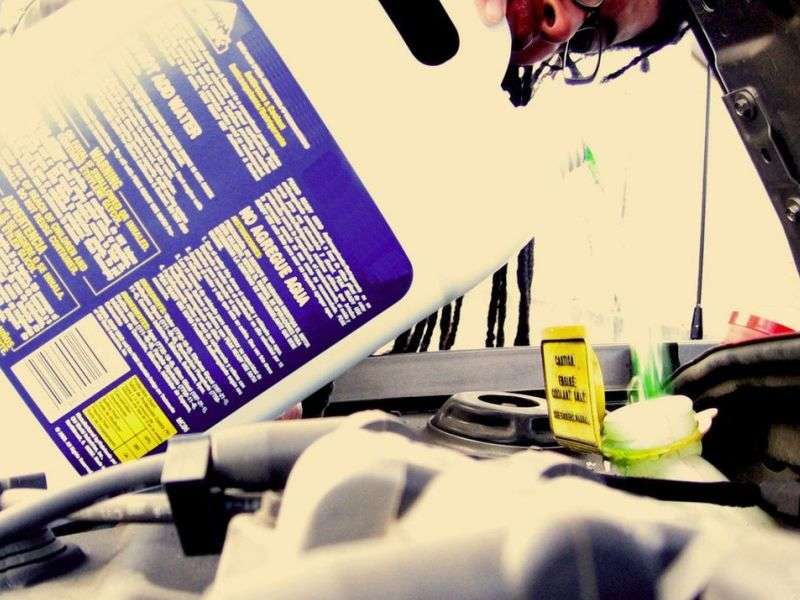Recent Articles
Popular Makes
Body Types
How to Test Antifreeze

pouring antifreeze
Coolant is a water and antifreeze mixture that is added to your engine periodically. The purpose of coolant is in keeping the engine from overheating by taking heat away from the engine and transporting the heat to the air in the radiator. Antifreeze also acts as an anti-corrosive agent. Water is corrosive to metals. The most familiar corrosion is rust. Rust develops as metals come in contact with air and water. Corrosion occurs with the other metals in a cooling system, copper, iron, aluminum etc. A good antifreeze coolant has an inhibitor combination to protect against corrosion. How do I know if my antifreeze is protecting my engine against corrosion? The easiest way to test antifreeze for corrosion protection is with test strips. Although strips test the freeze point of antifreeze, it can also determine if the antifreeze coolant has become corrosive or if it has anti-corrosive life left to protect the engine. Antifreeze test strips are a fast and accurate method of checking your antifreeze. Test strips measure the concentration of antifreeze coolant inhibitors in cooling systems using either conventional coolants. Regular testing of antifreeze coolant minimizes vehicle downtime and associated costs. Test strips are the only way to determine the exact depletion rate numbers of your antifreeze. An antifreeze coolant's inhibitors depletion rate is affected by variations in; • formulas • maintenance schedules • blow by gases • topping off • other atypical conditions found with the use of heavy duty diesel and gasoline engines. Test strips come packaged with a chemically treated pad attached to the end of a plastic strip. Immersing a test strip momentarily into a water and antifreeze solution begins the activation process. The strip caries a pH indicator, a reserve alkalinity indicator, a buffering agent and a pad that will change color to correlate with various concentrations and freeze points of antifreeze solutions. In comparative tests in hot Antifreeze between 70° and 90° C, it was determined that the color development is faster, and therefore the reading will be one color block darker than the reading of the cooler Antifreeze. Antifreeze should be less than 120° Fahrenheit. Colder antifreeze does not have an affect on the rate or final color development. Antifreeze of 120°F is cool enough to be handled and the radiator cap is cool enough to remove from the radiator. Generally, liquid in the overflow bottle is representative of the antifreeze coolant mixture in the vehicle. However if you just added additional 100% antifreeze to the overflow container, or if the level is very low, it would not be indicative of the mixture in the cooling system. • Test antifreeze coolant before any maintenance is performed. • Radiators are under pressure. • Do not remove the radiator cap on a hot engine. • Before removing the cap, wait until the temperature is below 50° Celsius (120° Fahrenheit). • Failure to wait may result in personal injury from hot coolant spray or steam. • Remove cap slowly to relieve all pressure. 1. Start with clean, dry hands and tools. 2. Test in a well lit area. Natural light is best. 3. Antifreeze coolant sample should be between 40° and 110° F. 4. Follow the test instructions enclosed with the strips. 5. Dip the reactive end of the test strip into the antifreeze coolant. 6. Test again if drain 1/2 or drain all maintenance is performed. 7. If the result falls between colors, select the block in between. 8. Read the color of the test strip after one but not more than after 3 minutes. 9. The pad's color will change as the pad dries. 10. Below 50° F read the color after 2 but before 5 minutes. 11. Use the test strips by the expiration date on the bottle. 12. Discoloration is caused by exposure for long periods above 100°F, direct sunlight, or leaving the bottle caps open for an extended period of time. 13. Replace cap on the test strip bottle to protect from moisture. 14. On occasion the dye in your antifreeze coolant may interfere with an exact match on the color chart. If this occurs, select the best match by color shade or depth. 15. Dip one test strip into coolant sample below 110° F for one second. 16. Remove the strip and shake once, briskly, to remove excess coolant. 17. Match the end pad (freeze point) and then the pad nearest the handle (pH) to the closest colors within one minute. 18. After one minute the pad's color may change as the pad dries. 19. Dispose of your used test strip with normal paper waste. 20. Dispose of your used antifreeze coolant in accordance with local regulations.